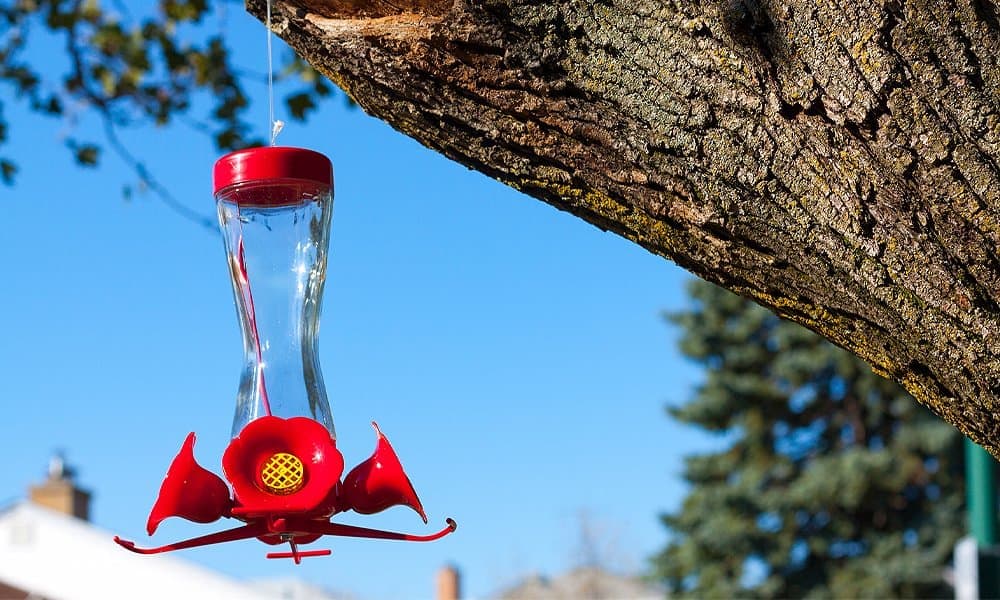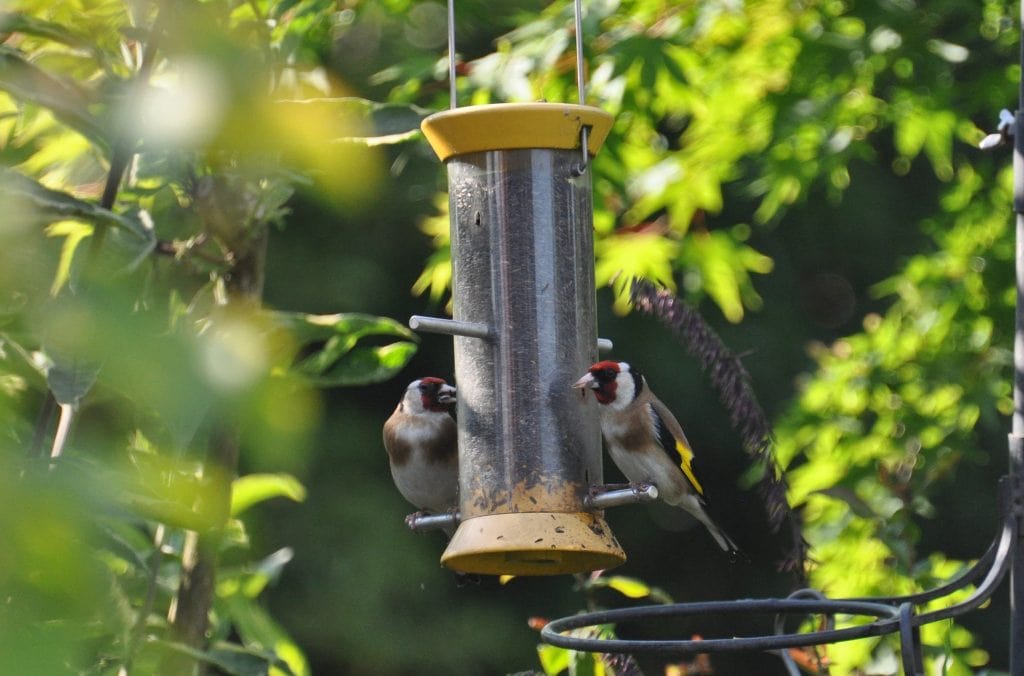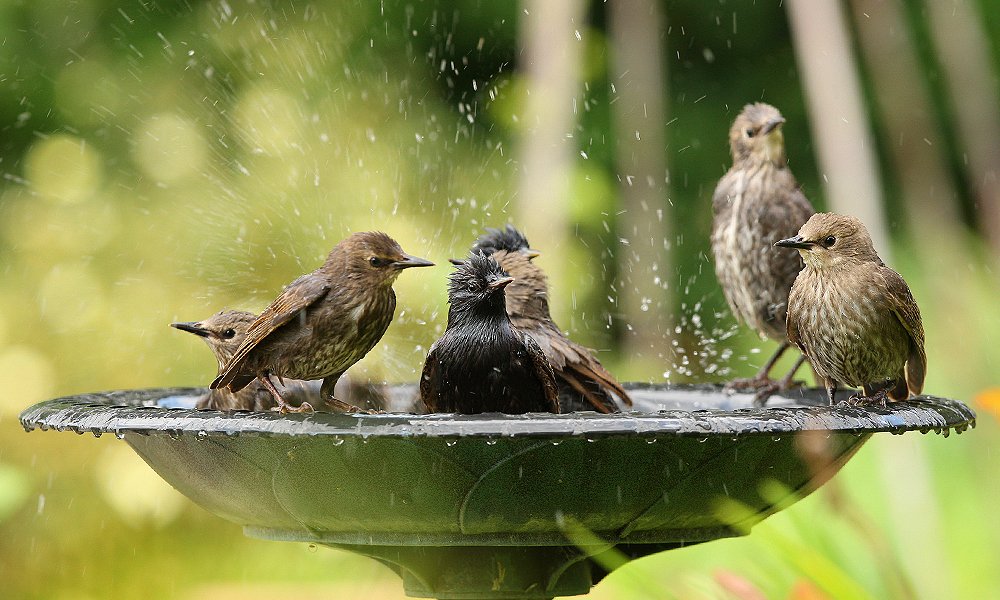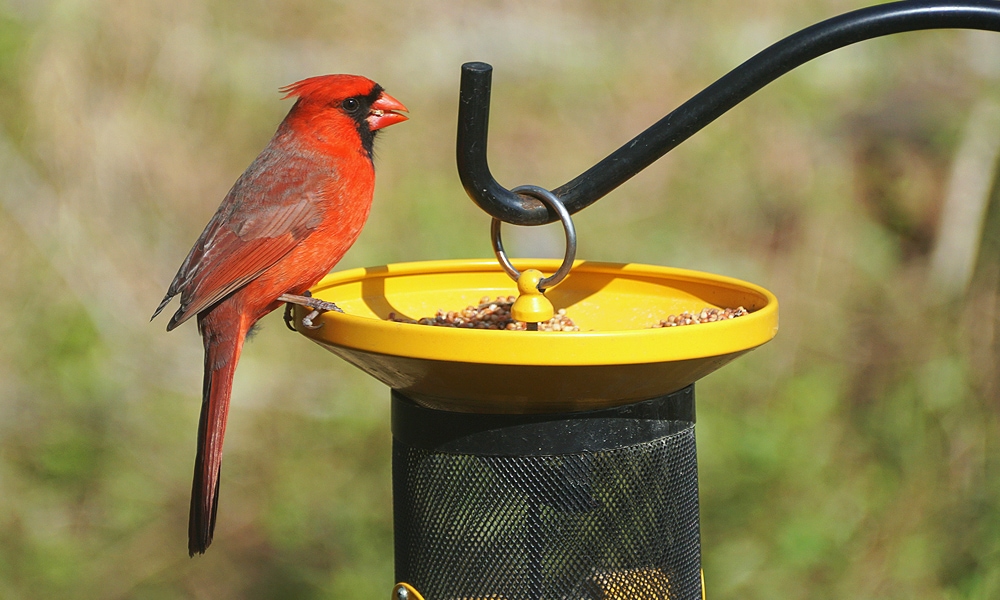Birds are a beautiful and charming addition to any outdoor space. Attracting them can be easy with the right feeder. Hanging a bird feeder may seem simple, but there are a few things to consider to keep birds coming back for both their enjoyment and yours.
How to hang a bird feeder can be a simple task that will bring you hours of enjoyment. Follow these tips and tricks for where to hang bird feeders and some things to consider when hanging bird feeders.
How to hang a bird feeder?
Bird feeders usually come with a hook or loop used to attach the feeder to something to hang, but it’s more than just simply hooking it on and walking away.
Hanging a bird feeder safely and securely is essential for both the birds and bird watchers.

Tree branch hooks
Tree hooks for bird feeders are an excellent way to hang feeders in a prime feeding location – trees!
Most feeders are designed to be hung and tree branches offer a perfect location that is both readily available (if you have trees in your yard) and is favorable for birds.
To hang a bird feeder from a tree appropriately and at the proper height, you may need to add an S-shaped hook. Look for those with deeper, strongly curved ends to withstand wind and birds landing on the feeder.
Readily available at hardware and outdoor supply stores, hooks add stability and robustness to hanging bird feeders.
Deck hangers
Decks can be an excellent space to attract birds. They provide the perfect location for viewing your feathered friends as they visit your hanging bird feeder.
A hanging feeder needs somewhere to hang, though, and deck hangers are a simple solution for where to hang bird feeders on a deck that doesn’t already have hooks or poles you can utilize.
Add a deck bird feeder pole or a bird feeder hooks off railings to give a close-up view of backyard wild birds.
There are typically three mounts to choose from (railing clamp mount, screw, and baluster), so choose the one that offers you the best bird feeder placement for your deck.
Yard feeder poles
Sometimes the ideal feeder location presents a challenge because there is nothing to hang a feeder from.
When mother nature can’t help with trees, and there are no structures nearby, create a bird feeder stand or bird feeder station by using a yard feeder pole.
The question of how to hang a bird feeder without a tree can be answered by either creating a DIY bird feeder pole or installing a bird feeder hanger pole.
A variety of pole kits offer many features from multiple hooks, to fancier options such as squirrel baffles, allowing you to create the perfect freestanding bird feeder station wherever you choose.
Window feeders
For a closeup view of your favorite songbirds, a window-mounted bird feeder is the perfect bird feeder placement.
Window hangers not only offer an intimate view but also offer a safe space for your birds to feed.
Feeders closer than 3 feet to a window or even attached to the glass offer a spot that provides excellent viewing but also minimizes window crashes through feeder placement.
Feeders are safer; the closer they are to a window as it prevents birds from reaching top speeds in the event of a collision.
Hang feeders from a bracket or use suction mounts to secure feeders directly to the glass for the best results.
Hanging brackets
Hanging brackets offer the ability to install a bird feeder in any location you can secure one too.
Whether it is a house, building, wall, or other things in your yard, if you can secure a bracket to it, you can hang a bird feeder from it.
Hanging brackets are especially useful for delicate feeders such as hummingbird or oriole feeders.
Nectar feeders require regular cleaning and are easily susceptible to ants, or other insects, so frequent changes are necessary.
Easy to reach brackets may be the best way to hang a bird feeder that requires frequent upkeep.
Not only do they allow you to add decorative elements in different places, but they can also help with where to hang bird feeders when you are challenged for natural locations.
Where to hang a bird feeder?
The two main considerations for where to put a bird feeder are whether you can see it and if it is in a safe location.
The following ideas are some things to consider for ideas for hanging bird feeders.

Non-windy location
Choose a non-windy location for your bird feeder to not only provide refuge for birds but also to discourage seed spill due to wind.
Free Standing bird feeders can be placed in non-windy locations, but bird feeder hooks or hangers may need to be removed during windy storms or other dangerous weather to prevent damage.
Wind can not only spread and spill seed and damage the feeder, but strong branches can add another element of danger for both the birds and feeders.
If your climate is especially prone to this type of weather, it may be best to place feeders in more sheltered areas.
Not only does this make it easier and safer for the birds to use, but it will make it easier for you to fill and care for as well.
Shaded area
Seed, nectar, suet, and other types of feed are all prone to spoilage if not cared for properly.
One way to protect the nutritious food the birds need is to place your feeder in a shaded area.
Protection from the sun keeps the seed or food from spoiling too quickly, giving your birds a better chance at maximizing their nutrition when they need it most.
Feeders are naturally messy, so regular cleaning is essential, and a shaded area offers the best protection from the elements.
Additionally, consider that while bright sunlight may make viewing easier, it can offer challenges in terms of photography.
A shaded area offers less glare and therefore, may be better for photography.
Near trees or cover
Birds need to feel both safe and comfortable to frequent a bird feeder.
Placing bird feeders near trees, shrubs, or other cover offers a convenient location for birds to seek refuge from predators, weather, and wait their turn for a place at a busy feeder.
Moreover, feeders perform best in a bird’s natural environment, so placing your feeder near areas where birds normally feed will increase your chances of attracting birds to your feeder.
Hang feeders near shrubs, trees, or bushes that can be used for both shelter and nesting.
Providing both safety and nesting to meet their needs offers birds a bigger incentive to stay in the area for more than just feeding.
The 5-7-9 rule
Squirrels come with the territory when it comes to bird feeding.
And while these curious rodents can be amusing to watch, they are still pests to the bird feeder, and some measures will need to be taken to avoid them taking over your feeders.
The accepted wisdom is that squirrels can’t (or won’t) jump more than 5 feet up from the ground, 7 feet across from a tree or building, and usually won’t drop more than 9 feet onto a feeder from above.
Place your feeder in a location that satisfies the magic squirrel ratio and you should be able to deter a large majority of these determined pests.
Create a distance from windows
Window collisions are a serious threat that injures and kills a large number of birds each year.
Birders can help protect birds by placing feeders at a safe distance from picture windows to minimize collisions.
Position feeders either less than three feet from a window or greater than 10 feet away from it.
Window mounted bird feeders actually help to minimize collision risks by their close placement, as noted above.
Feeders closer to windows reduce risk by minimizing speed (and therefore serious impact), while those further away provide enough room for the birds to safely maneuver and avoid a crash.
Bird feeder hanging tips to keep in mind
Clear view
Make the most of your bird watching opportunities by placing your feeders in a clear view. You need to have a proper view to enjoy the work you put into your feeders.
A well-placed feeder in a sunny spot will not only attract your regular birds but has a better chance of attracting passing birds as well.
Open placements with clear visibility allow birds to stay on the lookout for predators or other threats while offering a delightful sight to birdwatchers.
What’s more, bright sunlight may make it easier to see the vibrant colors and breeding plumage of many birds making for easier identification.

Refill often
Although there may be a technical best height for a bird feeder, placing a feeder in a location that you can easily access for refilling and cleaning is the best overall solution.
If you require extra steps to access your feeders, such as a ladder or step stool, chances are you will soon neglect it.
Keep your feeder full, refilling often, to attract more birds. A dependable food source is the most convenient one for the birds and stocking yours regularly will keep birds coming back for more.
Frequent refills also allow you to keep an eye on the health and condition of your feeder.
Birds can become ill from any moldy seed or droppings, so frequent refills help catch poor conditions before they worsen. Refill often and clean feeders regularly for the best results.
Shelter
Depending on your climate, your feeder can be exposed to a variety of elements.
Make sure your feeder is safe from the elements to protect both your birds and the feeder.
Climates, especially prone to strong winds, heavy rain or snowfall, and other adverse conditions, may find it best to place feeders in a sheltered location.
This allows birds to feed without bearing the brunt of the full force of the weather and will likely provide a welcome refuge when they need it most.
Moreover, you’re more likely to care for and refill the feeder if it is in a location that can be accessed in all weather, providing further security for your birds.
There will be a mess
From discarded seeds and hulls to molted feathers and droppings, bird feeders are naturally messy places.
Regular cleaning is essential, but you have to be prepared to put in the work to keep your stations as clean and mess-free as possible.
There are several things you can do to minimize the mess in addition to cleaning.
Position feeders where the mess is less visible, like a naturally brushy or grassy area, or employ seed trays to minimize the mess while still enjoying the view.
If one area becomes too polluted, you can always alternate locations to save on overuse.
How to keep squirrels away from bird feeders?
Feeding birds in your yard can be an exciting and rewarding hobby, but your beautiful feeders can be quickly overrun by squirrels if you do not take precautions.
The most attractive feed to birds, such as black-oil sunflower seed and suet, are also attractive to squirrels, and they have a voracious appetite and attitude that often scares away the very birds you meant to feed.
Read on for just some of the ways to keep squirrels away from bird feeders.

Squirrel proof feeder
Some feeders are specifically designed to prevent squirrels and larger birds from being able to access the seed.
This can be accomplished through cages or specially designed doors and hatches that are triggered to close by a squirrel’s weight.
This option may be best for particularly enterprising squirrels that have already destroyed your other efforts or feeders.
Squirrel baffle
Baffles are designed to prevent squirrels from accessing the food from either above or below.
Baffles should be at least 15-18 inches wide or long to prevent squirrels from reaching around the baffle to get to the feeder.
Many baffles include all the bells and whistles designed to tilt or twirl to throw the squirrel off balance.
This option works best for feeders on poles or hung from trees.
Squirrel proof feeder pole
Lastly, you can buy specific poles with baffles already attached to outwit these athletic seed thieves.
Sturdy poles that won’t bend under the weight of the squirrel with baffles already attached may be your best defense against, particularly determined squirrels.
Baffles come in a variety of styles and squirrel proof feeder poles can often hold more than one feeder, creating a squirrel free station for your birds to feed at.
What to do if birds are not coming to your bird feeders?
The first thing to check if birds are not coming to your bird feeders is your patience.
It can take time for birds to notice the new feeder, and even longer for them to brave the hunt and scout out the new location.
If, after 2-3 weeks, you are still not having any luck, try moving your feeder to another location and let the wait begin again.
Where to place bird feeders can be very location-specific. There can be many reasons why birds will not use feeders at a specific location.
Try observing your location to highlight any obvious indicators (like predators), but be sure to check for less obvious factors like spoiled food or unseen predators.
If all else fails, here are some additional tips to make your yard more attractive to birds.

Add a bird bath
Water sources are essential to birds and providing a reliable water source is just one way you can make your yard more attractive to birds.
Birds need water to survive, and providing water for them is key to their health and habitat.
Choosing the best bird bath to keep your birds happy and healthy means not only finding one the birds will use but is also one that is easy to keep clean.
There are many types of bird baths to choose from. When considering which bird bath to choose, keep in mind type, size, location, ease of cleaning, and price.
Install bright colors
Like us, birds are one of the few animals that can see in color and they rely on it in a variety of ways.
From attracting a mate to hiding from predators and almost everything in between, color can play an important role in a bird’s existence. Make your yard especially enchanting by the placement of colors known to attract birds.
Red is especially known to attract hummingbirds and many feeders come in a bright red hue to catch their eye. While orange and yellow have been known to attract Orioles and Goldfinches and feeders specific to them often come in these hues.
In general, birds are attracted to their own color, so incorporating blue items into your yard, either through feeders or other decorative items, is sure to attract Blue Jays and other blue birds.
Adding color can be done in a variety of ways from artificial installments such as bird feeders and houses, to planting naturally vibrant shrubs and flower varieties attractive to birds.
Birds will always be most attracted to those colors associated with foods they eat so planting native trees and species of plants will not only entice birds to see what your yard has to offer but will provide a much needed environmental wonderland for your birds.
Provide nearby perches
All birds need a place to rest, preen, or simply take in the landscape.
Provide nearby perches through natural structures such as trees or bushes, or if your yard doesn’t offer those, install a perching stick to create a safe place for your birds to rest.
Whether birds need to stop and take a break from their migratory activities, or they’re looking for a spot to preen their feathers, providing nearby perches offers them this much needed safe space.
Birds often use perches to scan the area and assess danger, making a decision about the safety of the feeder as well. Native trees and landscaping are always best, but perching sticks can be used when these aren’t available.
Don’t place them too close to feeders, though, as it may give predators an unnecessary advantage. Perches can be made from a variety of materials, or you can use old branches to mimic a more natural setup.
Check seed levels regularly
Attracting birds comes down to providing for their basic needs, so check seed levels regularly to ensure their nutritional needs can always be met at your feeders.
Tempting birds with the right treats is another excellent step in meeting their needs and providing them a safe haven.
Different birds eat different things, so giving them a choice will attract the most variety to your yard.
Checking levels regularly also allows you to keep an eye on the health of your feeder stations, warding off any potential mess or pollution as soon as you see it.
Birds will appreciate a predictable food source that is clean, even more so.
Frequently asked questions
How to hang a bird feeder outside a window?
Bird feeders can be hung outside a window either through a special bracket or window mounted feeder. Most window mounts rely on a clear plastic bracket or hook with suction cups. The heavier the feeder, the more suction cups you will need to hold it up.
How to hang a bird feeder off a deck?
Bird feeder hangers for decks usually come in three different mounting styles. Railing clamp mount, screw mount, and baluster mount can all be used to attach a pole or bracket to your deck that will hang your bird feeder. You can also use additional bird feeder hooks to hang feeders from the pole.
How to hang a bird feeder on balcony?
All it takes is a good railing clamp and a bird feeder hook to have a balcony bird feeder. You can use either a railing clamp or a deck hook with a mounting bracket (depending on your railing) to hang a bird feeder on a balcony.
Can bird feeders be too close together?
Some birds can become territorial about feeders. To combat this behaviour, place feeders at least 3 to 4 feet apart to give birds the space they need.
Where do you hang a bird feeder?
Where is the best place to hang a bird feeder depends largely on the type of space you have. Hang your bird feeder away from trees, bushes, or populated areas for the best results.
How high should a bird feeder be hung?
Bird feeders should be hung at least 6 feet off the ground to prevent predators and pests from interfering with feeding or attacking your birds.
How long does it take for birds to come to a bird feeder?
It can take several weeks for birds to discover your feeder. Add a shiny pie plate with some seed in it or bright colors to help them find it faster.
How do you hang a bird feeder between two trees?
To hang a bird feeder between two trees, you need to either install a rope or wire as bird feeder hangers or utilize specific bird feeder hangers for trees (hooks to install directly onto the tree).
What is the best way to hang a suet feeder?
The best way to hang a suet feeder is alone and away from other feeders. Birds that thrive on suet are often shy birds that will appreciate the solitude.
How do you hang a bird feeder from a high branch?
To hang a bird feeder from a high branch, you can utilize a ladder and bird feeder hangers for trees or a tall bird feeder pole with a pulley. A pulley system allows you to reach otherwise out of reach locations.
Can you put a hummingbird feeder next to a bird feeder?
Hummingbirds are easily intimidated by other birds, so it is never a good idea to place their feeders next to other bird feeders where they can be startled.
How do birds find bird feeders?
Birds rely primarily on their source of vision to find seed at bird feeders. Once one bird has found the seed, other birds of the same species will follow.



What is the best ground cover for under the bird feeder and around my 2 bird baths? One bath is low at ground level and one is standard height.
Ps… Where’s the best place to buy reasonably priced bird food??
I have a metal railing. Which type of the 3 types of mounts that you talk about would be best from which to hang my bird feeder? Thanks.